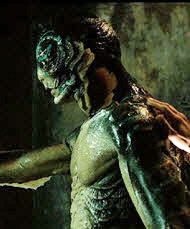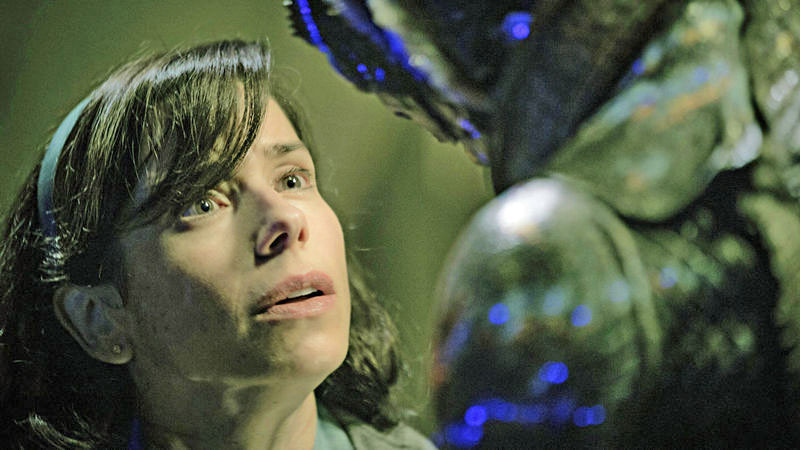The Shape of Water
 for sexual content, graphic nudity, violence and language.
for sexual content, graphic nudity, violence and language.
Reviewed by: Jonathan Rodriguez
CONTRIBUTOR
| Moral Rating: | Extremely Offensive |
| Moviemaking Quality: |
|
| Primary Audience: | Adults only |
| Genre: | Fantasy Drama |
| Length: | 2 hr. 3 min. |
| Year of Release: | 2017 |
| USA Release: |
September 2, 2017 (festival) December 1, 2017 (select—NYC theaters) December 8, 2017 (41—select theaters) December 15, 2017 (158 theaters) DVD: March 13, 2018 |




Loneliness
About hope
TRUE LOVE—What is true love and how do you know when you have found it? Answer

1960s cold war period in American and Soviet Union history

Torture
Hollywood portraying Christians as being evil

RACISM—What are the consequences of racial prejudice and false beliefs about the origin of races? Answer
anti-semitism

GAY—What’s wrong with being Gay? Answer
Homosexual behavior versus the Bible: Are people born Gay? Does homosexuality harm anyone? Is it anyone’s business? Are homosexual and heterosexual relationships equally valid?
What about Gays needs to change? Answer
It may not be what you think.



| Featuring |
|---|
|
Sally Hawkins … Elisa Esposito Michael Shannon … Strickland Richard Jenkins … Giles Octavia Spencer … Zelda Michael Stuhlbarg … Mr. Robert Hoffstetler Doug Jones … Amphibian Man David Hewlett … Fleming Nick Searcy … General Hoyt Stewart Arnott … Bernard Nigel Bennett … Mihalkov Lauren Lee Smith … Elaine Strickland Martin Roach … Brewster Fuller See all » |
| Director |
| Guillermo del Toro — “Crimson Peak” (2015), “Pan's Labyrinth” (2006), “Hellboy” (2004), “Blade II” (2004), “Mimic” (1997), “The Devil’s Backbone” |
| Producer |
|
J. Miles Dale Guillermo del Toro See all » |
| Distributor |
 Fox Searchlight Pictures, a sister company of 20th Century Fox, a division of The Walt Disney Company |
Guillermo del Toro’s “The Shape of Water” is, as described by the narrator in the opening scenes, “a tale of love and loss and a monster who tried to destroy it all.” Sally Hawkins plays Elisa, a cleaning lady working the night-shift at a secret government research facility in Baltimore in the 1960s. She is mute, having suffered a traumatic, and mysterious, injury as a child that also left her orphaned and permanently wounded, with scarring on both sides of her neck. She lives in an apartment above a twenty-four hour movie theater, across the hall from Giles (Richard Jenkins), a lonely, struggling artist who works in a medium that time is moving away from. Elisa’s only other friend is Zelda (Octavia Spencer), a fellow cleaning lady who, like Giles, uses Elisa’s muteness as permission to talk non-stop, mostly about herself.
The two women are cleaning a lab one night when a tank filled with murky water is rolled in under heavy security. Elisa, ever intrigued by her surroundings, runs her hands along the tank while the government officials are off to the side talking. A hand emerges from the water, hitting the underside of the tank, startling Elisa. It isn’t so much the quick emergence of the hand that startles her, but the fact that the hand is, well, not exactly human. It belongs to an amphibious man-like creature (frequent del Toro collaborator Doug Jones) discovered in the rivers of South America, believed by the locals to be a god, which has the ability to breathe both in and out of water and which may possess miraculous powers.
The U.S. Government has captured it and plans to study it as much as possible, under the direction of Richard, the sadistic government agent (Michael Shannon) who brought the creature in, and under the watchful, more compassionate eye of the resident biologist Bob (Michael Stuhlbarg). But, they also know that, in the height of the Cold War, the Russians will be after it, too. And, while learning about the creature is a bonus, keeping the Russians from learning about it is even more important.
Because Elisa and Zelda were the women cleaning the lab when the creature arrived, Richard assigns them the task of being the only members of the large cleaning crew allowed into the lab. Elisa, who is completely fascinated with the Amphibian Man, takes full advantage of this privilege, sneaking in during her “lunch” breaks to spend more time around the creature. She slowly begins to realize that there is more to the creature than the scientists have discovered. Elisa also uncovers the government’s true plans for her new friend, and attempts to rally the few troops she has to pull off a heist to save him.
I am going to try to tackle this review for a few different types of readers that I know frequent this site. I know there are potential viewers who are mainly concerned with the objectionable content. I know there are also potential viewers who may care less about objectionable content and more about the spiritual aspects of the film. And, lastly, I know there are people who don’t care much about objectionable content or spiritual subtext and only want to know if the movie is worth seeing from an artistic perspective. So, here we go.
“The Shape of Water” is rated R for “sexual content, graphic nudity, violence, and language.” Another way to say that—“The Shape of Water” is very much an adults-only movie. I say that because, at the 10pm showing I attended, a young mother came into the movie with her 6 or 7 year old daughter, and it stunned me. I get that sometimes you can’t get a babysitter, but… really?? I digress.
Why does God warn us about it? Answer
Anyway, the nudity comes early and often in this movie. Within minutes, the audience is shown both rear and full-frontal female nudity, as a character gets into a bathtub. While the woman is in the bathtub, we hear (but can’t really see, because the camera gaze is on a different object, and the woman is out of focus in the background)—the woman is masturbating. We then learn shortly thereafter that this is apparently part of her daily routine, as she does it again. Female nudity is displayed at various other points in the movie, some of it briefly, and some for longer periods of time. Rear male nudity is shown during a relatively graphic sex scene, which also features the woman complaining that the man’s hand is bleeding on her and the man then using that hand to cover her mouth to keep her quiet.
A man uses his position of power to harass Elisa, suggesting that, even though she is mute, he looks forward to trying to make her “squawk.” A male character has a crush on a man who runs the counter at a pie restaurant.
The language is very strong at times. The violence is more intense than I expected. The Amphibian Man is tortured throughout the movie. Blood is not only frequently seen during torture scenes, but also from a surprisingly large number of gunshot victims in the film. One man is shot in the mouth, with the bullet entering through one cheek and exiting through the other. The man is then dragged by another man, who uses the bullet hole in the mouth as a grip to drag him. It’s a harrowing scene. Fingers are bitten off and a throat is bloodily sliced open. Suffice it to say, the content in “The Shape of Water” is extreme, and viewers are urged to use strong caution and discernment—and this film is absolutely not for children.
There is really only one character who references God or Scripture in any way, and that is Michael Shannon’s sadistic government agent. He mentions early on to Elisa and Zelda that the amphibious creature can’t possibly be human, because human beings are created in the image of God, and God can’t possibly look like that. He believes that God looks more like him—like them. He then looks at Zelda and says that God probably looks much more like him than He does her, clearly referencing her race.
Zelda’s middle name is Delilah, and he asks her if she knows the Bible story of Samson and Delilah. She says she’s not too familiar with the Good Book, so he explains the story to her. He uses the story several times throughout the remainder of the film to prove points he is trying to make. The Amphibious Man is supposedly revered as a god-like creature back in South America, and as we get to know more about him, we see that he possess abilities far beyond anything human.
I won’t delve into spoilers, but I will go so far as say that at one point in the film, after a major scene, one character says to the Amphibian Man, “You really are a god.”
Now, I have said in reviews before, I don’t go into Hollywood movies expecting them to align with my worldview or my beliefs. If I did, I’d likely never go. But there have been a few films I’ve seen over the years where it seemed the filmmaker’s objective was to paint the worst character in the movie as being the “Christian.” Again, I also realize that there are plenty of outwardly professing, supposed “Christians” in the world who give true followers of Christ a bad name, and I’ve seen movies that balance characters like that with characters who profess faith and actually live it out in a respectable way. There is no balance in “The Shape of Water.” There is only one supposedly “Christian” character, and he is the monster the narrator refers to in the opening scene.
Now for the artistic merits of “The Shape of Water.” It’s a gorgeously shot movie. Guillermo del Toro is famous for creating beautiful-looking movies, and this may be the prettiest one—if one is willing to overlook the vulgarity and bloody violence.
Sally Hawkins is one of my favorite actresses in the world, and probably the best, lesser-known actress around. She was great in “Maudie,” a film released earlier this year about a Canadian painter with a crippling disability. As good as she was in that movie, she’s even better in this one, speaking only in sign language and facial expressions.
There is one incredible scene where she tells her neighbor why she feels so strongly about her new amphibious friend; that is the single best scene in the movie. That friend is played by Richard Jenkins, who is also fantastic in the movie. Michael Shannon and Octavia Spencer are good, but I couldn’t help but feel they played very much to type. We’ve seen them play these roles before, and it made me wish they had cast people we weren’t used to seeing as characters like this.
The story itself is compelling, much like similar woman/creature stories like “Beauty and the Beast” or “King Kong” have been compelling, and may appeal to people drawn to those types of movies—or to people drawn to romance, sci-fi, Cold War, or creature feature movies, because “The Shape of Water” is pretty much all of those things.
I think, though, that at its core it is really a movie about an outcast falling in love with, and wanting to protect, someone who is even more of an outcast than she is. Elisa has a very small group of friends, but they are all outcasts to some extent—a mute, an African American cleaning lady, and a struggling homosexual artist. In the 1960s, none of these people would have been warmly welcomed in society, and the friendship bond between them all is completely believable.
Elisa is a very strong character, and I was drawn to her immediately. Unfortunately, I can’t say the same for the Amphibian Man. I was fascinated by him, but I wasn’t able to emotionally invest in him. At least not in the way I was emotionally invested in characters like The Beast or King Kong, or even E.T., for that matter.
In fantasy, we have to be drawn to that fanciful character, and invest ourselves into them. And, while I know many people who have seen this movie have been able to completely invest emotionally, I simply wasn’t able to. Judging from most secular reviews, I am definitely in the minority on this one. “The Shape of Water” is already on many top ten lists and will likely earn quite a few Oscar nominations.
But, as the credits rolled and the crowd began to disperse, I found myself oddly unmoved. Movies usually wrap me in quickly and don’t let go until long after the credits roll, but as I got into my car to leave the theater, I was already thinking about other things.
For people looking for wholesome holiday entertainment, “The Shape of Water” is not it. For Christians looking for a faith-affirming movie to get lost in during the holiday season, “The Shape of Water” is not it. For those looking for something somewhat artistically beautiful, well-acted, and highly regarded by secular critics, you might find what you are looking for in “The Shape of Water.” But I did not.
- Nudity: Extreme
- Sex: Extreme
- Violence: Very Heavy
- Profane language: Very Heavy—“G*d-d*amn,” “Oh my G*d” (3), “H*ly J*sus,” “Oh G*d” (6), “G*d-awful,” “Good God,” “For G*d’s sakes,” “Dear G*d,” “G*d” (3), “L*rd,” “H*ll” (5), “d*mn” (4)
- Vulgar/Crude language: Very Heavy—m*therf***er, f-words (14), p*ssy, cr*p
Once again, Hollywood not only wants your money, they want your mind. Director Guillermo del Toro is a self-described “raging atheist.” We regularly ask that followers of Christ pray for him. He is spiritually heading in the wrong direction, and he continues to use his talents to produce very offensive films that promote his Godless and very Liberal political worldviews—shared by so many in Hollywood.
Despite what may be attractive and poetic about “The Shape of Water,” it is profane, vulgar, lust-provoking, very violent, and pokes at Christians and belief in the Bible. It is designed in a way that can appeal to many people and seductively lead naive viewers away from God and toward a particular political agenda and worldview.
In a recent interview, del Toro made it clear that the film is full of ‘coded commentary’ supporting and promoting his views. This film is not about the 60s, it is “about today. It’s about everything that we’re dealing with today,” he said. Speaking of the current political situation, del Toro says,
“We are beyond words right now, we are beyond truth, but if I tell you, ‘Once upon a time in 1962, in a country not far away, there was a woman …’ then the movie is a fairy tale for troubled times. And you lower your guard and you accept to discuss with me what makes us human, what makes us connect, without the guard for reality, with the authenticity of a fairy tale. Because fairy tales are not realistic, but they’re authentic.”
Del Toro is particularly known for his horror films. In a revealing Time interview, he made it clear that, for him,
…the horror film is a very political genre… Much like fairy tales, there are two facets of horror. One is pro-institution, which is the most reprehensible type of fairy tale: Don’t wander into the woods, and always obey your parents. The other type of fairy tale is completely anarchic and antiestablishment.
Christian Spotlight strongly recommends that followers of Christ not support or view this manipulative and spiritually bankrupt film.
If you want to find the truth about this universe, and you want to flee from lack of love and from the doom of eternal loneliness and utter despair that looms in your future, earnestly seek the One True God and discover His revealed plan. Learn the true nature of mankind and of the pervasive evil that surrounds us. Repent of your own sinful actions and thoughts and continual failures to do what is good and right, and accept the gift of redemption that God freely offers. Discover what love truly is and the joy of what eternal life will be for those who become the sons and daughters of our Creator.
See list of Relevant Issues—questions-and-answers.


Moral rating: Better than Average / Moviemaking quality: 4
Moral rating: Average / Moviemaking quality: 5
Moral rating: Offensive / Moviemaking quality: 5
Why does the pie man have to be a racist? Why does the main character have to resort to bestiality… which is a sexual assault carried out by her on her seemingly innocent and child-like creature friend who was already fulfilled with her loving and kind attention and treatment? So unnecessary!
Why does the only professed Christian in the film have to be more monster-like than the actual monster? The film would have been excellent without all that icky nonsense! Too bad! Seems like the writer, producer, director has some serious issues! Run, don’t walk… away from this movie!
Moral rating: Extremely Offensive / Moviemaking quality: 5
Moral rating: Extremely Offensive / Moviemaking quality: 5
Negatives: Unnecessary masturbation/sex scenes. Bestiality (normalizing for Hollywood now). All white males were evil, especially the military, except if the gay guy of course. Predictable (maybe that’s why some folks liked it). No redeeming value. Worst movie I can remember. Don’t waste your money or poison your mind (when its free).
Moral rating: Extremely Offensive / Moviemaking quality: 3
PLEASE share your observations and insights to be posted here.
Moral rating: Extremely Offensive / Moviemaking quality: ½



The main character acts as I hope we all would act in showing courage to do the right thing to protect an individual who lacks the power to protect himself. The film is a roller coaster ride, and an absolute joy to watch, despite the foul language and nudity.
My Ratings: Moral rating: Offensive / Moviemaking quality: 5